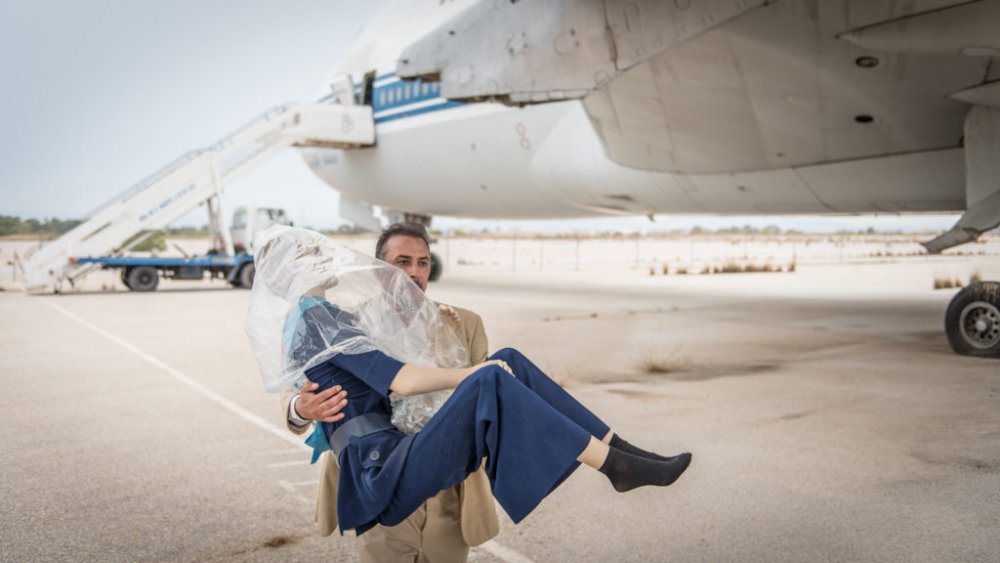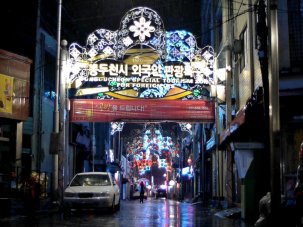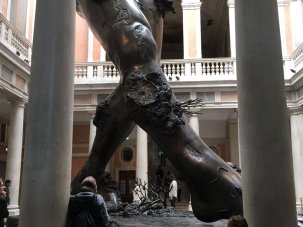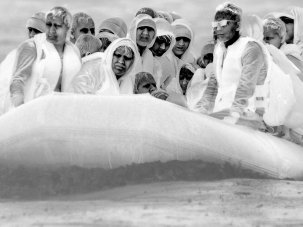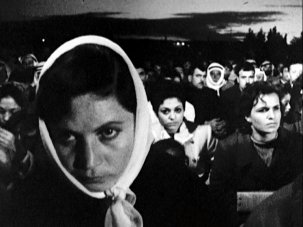Cinema found itself in a strange position at the 2017 documenta, the 14th edition of a quinquennial art exhibition held in Kassel, Germany (with further exhibits in Athens), considered to be the single most important event of its kind. That was because film got away with things the rest of the arts at documenta 14 generally didn’t – for instance, being communicative, argumentative, accessible, sensual and sometimes even playful.
documenta 14 ran 8 April-17 September 2017 in Kassel, Germany and Athens, Greece.
In general, the exhibition was regarded as a bleak triumph of art-world theory-speak over communication, by an enraged bourgeois mainstream; documenta 14’s artistic director, Adam Szymczyk, had unleashed an all-out assault on the patron class’s tastes and canons, exemplified by a preference for confrontational political works, as well as a fascination with artists belonging to ethnic minorities or social communities outside the white heterosexual Christian norm. There was no fêting of the Art Basel coterie, no paintings or sculptures you could just, you know, like at this exhibition. No wonder that, for example, Norwegian Sami Máret Ánne Sara’s installation Pile o’ Sápmi, which includes a gigantic curtain fashioned from reindeer skulls, exuded such a morbid fascination; ditto that Maria Eichhorn’s massive installation on Nazi plunder and art restitution, the Rose Valland Institut, became one of the most talked-about endeavours on display.
Romuald Karmakar’s Denk ich an Deutschland in der Nacht trailer
Furthermore, film seemed to be the only art form represented in good measure by heavy-hitters: internationally established or up-and-coming auteurs who presented new, often documenta co-produced works that were also showcased this year at key festivals such as Berlin (Romuald Karmakar’s Denk ich an Deutschland in der Nacht…) or Locarno (Narimane Mari’s sophomore effort Le fort des fous). Documenta 14 featured new films and installations by the likes of Roee Rosen (The Dust Channel), Naeem Mohaiemen (Two Meetings and a Funeral), Amar Kanwar (Such a Morning), Romuald Karmakar (BYZANTION – Agni Parthene (Greek version) & Agni Parthene (Church Slavonic version), Susan Hiller (Lost and Found), Angela Ricci Lucchi & Yervant Giankian (Journey to Russia, 1989-2017) and Artur Żmijewski (Humanity, 2017). In addition, Wáng Bīng was honoured by way of an almost complete retrospective, and Jonas Mekas too received a small tribute.
One should mention that these filmmakers’ works were also shown in spaces that made them a joy to behold, with good projection and often decent seating; the less widely known such as Anna Daučikova (Thirty-three Situations, 2015), Eúa StefanīÏ (Akrópolī, 2002/04) and Kōnstantínos Chatzīnikoláou (Woyzeck, 2017) had to make do with less hospitable conditions; which was still better than what was done to Vadim Sidur’s Pamjatniki Sovremennomu Sostojaniju (1973) or Geta Brătescu’s Atelierul (1978), both cheekily enigmatic gems of autobiographical cinema from the fringes of Communist-era art production, which were running in digitalised form on monitors in places where it was almost impossible to watch them.
Amar Kanwar’s Letter 5 (Such A Morning) trailer
The Dust Channel and Two Meetings and a Funeral encapsulated what documenta 14 could have been if Szymczyk et al had opted for persuasive reasoning rather than confrontation. The Dust Channel is Israeli multi-disciplinary agent provocateur Rosen’s greatest film so far, a surrealist film opera with many a Brechtian touch, in praise of – a vacuum cleaner!
The dust dealt with here on an everyday basis slowly turns into the sand of the desert (where refugees are held in inhuman conditions, ostensibly to make them leave of their own free will), and finally becomes the dust swirling in our brains – the seemingly endless mass of bits and stuff that make up our image culture in all its gruesome absurdity. Structured like an essay with a pamphleteering edge, delivered with a world-class entertainer’s sense of panache and glee, The Dust Channel became one of documenta’s most widely beloved and celebrated works – people queued for hours to watch it.
Two Meetings and a Funeral excerpt
Two Meetings and a Funeral is directed by Naeem Mohaiemen, Bangladesh’s caustically circumspect artist/essayist cum counter-chronicler of the (mis)adventures of 70s leftwing politics. If this work was less often talked about, it may have been to do with its length; to really engage with it one needs to watch the whole hour and a half, which few managed, what with the plethora of other things to see. But those who did stay were quickly hooked by the three-channel essay’s narrative on the dismantling of post-war promises and hopes, exemplified by the rise and collapse of the Non-Aligned Movement.
Once again, Mohaiemen’s native Bangladesh becomes the story’s focus, particularly the way in which this relatively small country attempted to navigate the murky waters of anti-imperialist global politics. As ever with Mohaiemen, Two Meetings and a Funeral is full of fascinatingly off-kilter scenes that at first feel like digressions, eg a sudden monologue by the story’s cicerone on modernist architecture and revolutionary ‘third world’ governments, or a curiously erratic debate with a politician. Yet, however perplexing a scene might seem at first, it always has its meaning in the film’s woven pattern – nothing here is gratuitous.
Tripoli Cancelled trailer
And as if that wasn’t enough, Mohaiemen also had a fiction feature on offer, his first: Tripoli Cancelled, in which a man is caught in a transit situation seemingly eternal and acted out in the ruins of Athens’s old airport. He shaves carefully. He reads Watership Down. He remembers moments from his life. He walks through impossibly long corridors and monumental halls. He plays pilot in airplane wrecks. He engages in lewd activities with a doll. He does everything a man lost to the world does in an apparently unlimited space – an existentialist version of Marlowe’s hell. But in an eerie way, he actually seems happy.
Few and far between are the films carried by a single human presence, where performance and acting, stage and installation art fuse into such a unique whole. If documenta 14 were only remembered for these two works by Naeem Mohaiemen, it would already have been worth the time and money spent.
-
The Digital Edition and Archive quick link
Log in here to your digital edition and archive subscription, take a look at the packages on offer and buy a subscription.




